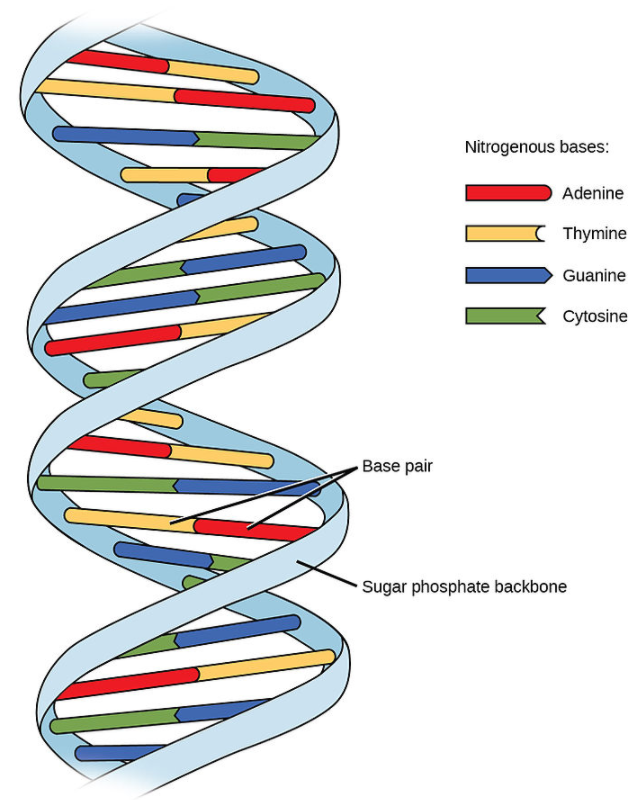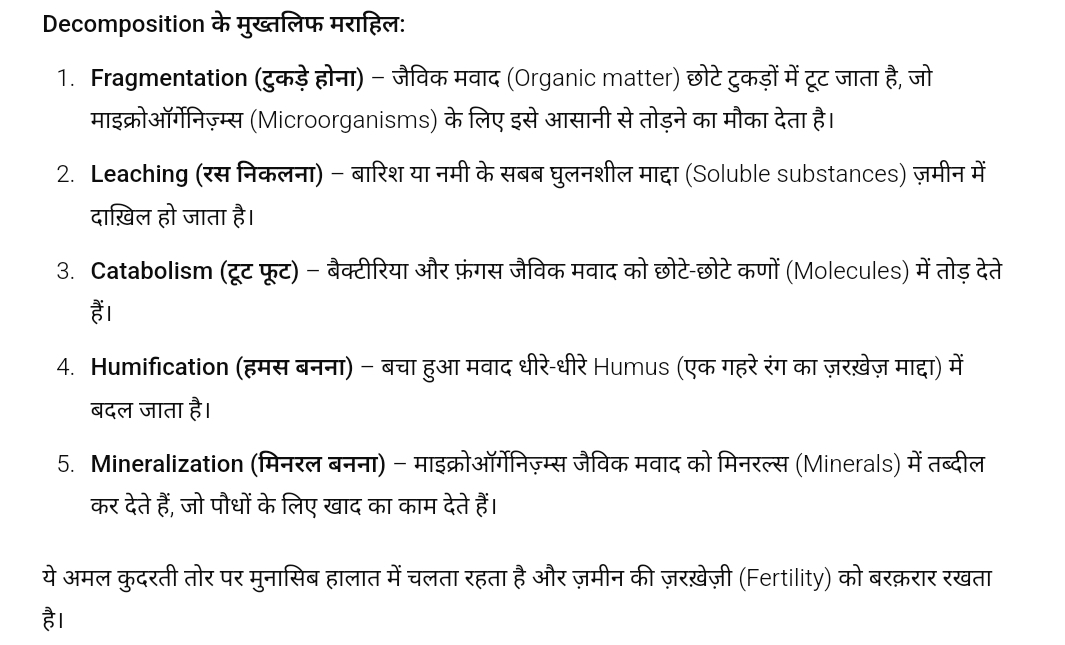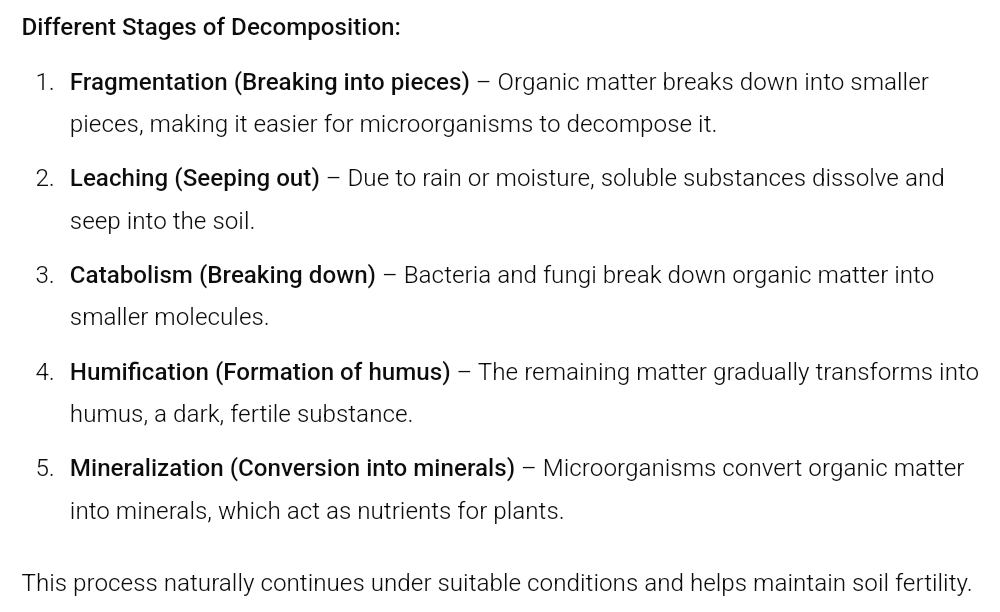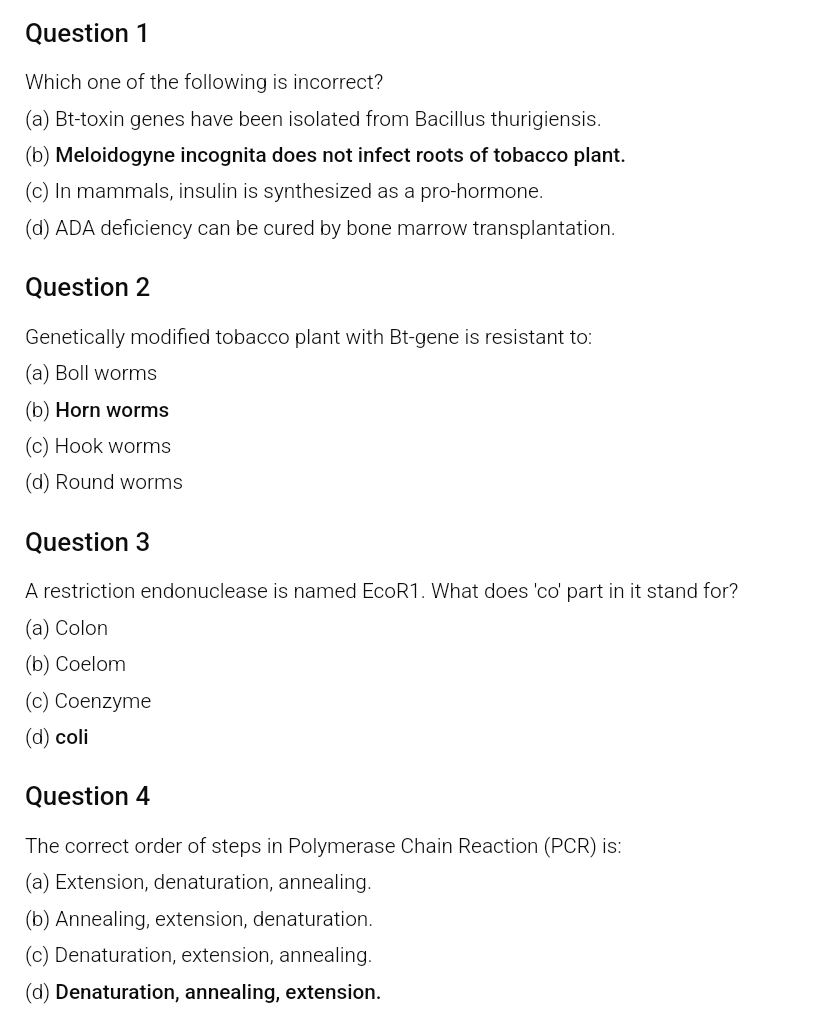Question What is Gene therapy? Illustrate with the example of adenosine deaminase (ADA) deficiency.
Question From which organism statins are produced? What is the role of statins in medicine.
Answer Biofertilizers are the living microorganisms that help in the growth and development of plants or crops by enhancing the availability and supply of primary nutrients to the plant. Rhizobia are the bacteria that help in the nitrogen fixation and thus help in replenishing soil nutrients and act as biofertilizers.
Biofertilizers वो living microorganisms हैं जो पौधों या फसलों के growth और development में मदद करते हैं, क्योंकि ये पौधों को primary nutrients की उपलब्धता और supply बढ़ाते हैं।
Rhizobia वो bacteria हैं जो nitrogen fixation में योगदान देते हैं, जिससे मिट्टी के पोषक तत्व फिर से भर जाते हैं और ये biofertilizers के रूप में काम करते हैं।

Question What are transgenic animals? Give the common reasons for developing transgenic animals.
Answer Transgenic animals are the animals that have had a foreign gene deliberately inserted into their genome. They are useful as disease models and producers of substance for human welfare. Some transgenic animals are produced for specific economic traits. For example, transgenic cattle were created to produce milk containing particular human proteins, which may help in the treatment of human emphysema.
Transgenic animals वो जानवर हैं, जिनके genome में जानबूझकर एक foreign gene डाला गया है। ये disease models के तौर पर काम करते हैं और human welfare के लिए जरूरी पदार्थ भी बनाते हैं। कुछ transgenic animals खास आर्थिक गुणों के लिए बनाए जाते हैं। उदाहरण के तौर पर, transgenic cattle को ऐसा दूध बनाने के लिए बनाया गया था, जिसमें particular human proteins शामिल हों, जो human emphysema के इलाज में मदद कर सकते हैं।
Question Write any four salient features of the double helix structure of DNA.
Answer Hint: Deoxyribonucleic acid (DNA) is a molecule which is composed of two polynucleotide chains that are coiled around each other to form a double helix carrying the genetic information of an individual. This genetic information gives instruction for development, growth, functioning and reproduction in all known organisms.
Deoxyribonucleic(डिऑक्सीराइबोन्यूक्लिक) acid (DNA) एक molecule है, जो दो polynucleotide chains से मिलकर बना होता है। ये chains एक दूसरे के चारों ओर coil होकर एक double helix बनाती हैं, जिसमें एक व्यक्ति की genetic information होती है। यह genetic information सभी known organisms में development, growth, functioning और reproduction के लिए instructions देती है।
The salient features of the double helix structure of DNA are as follow:
- The structure of the double stranded DNA consists of two polynucleic chains and the backbone of these polynucleic chains is constituted by the sugar phosphate. These both polynucleic chains possess anti-parallel polarity which means that one chain has polarity 5’-3’ and the other chain have polarity 3’-5’.
- The structure of the double stranded DNA consists of two polynucleic chains and the backbone of these polynucleic chains is constituted by the sugar phosphate. These both polynucleic chains possess anti-parallel polarity which means that one chain has polarity 5’-3’ and the other chain have polarity 3’-5’.
DNA की double helix structure की मुख्य विशेषताएँ निम्नलिखित हैं:
- DNA की double stranded DNA में दो polynucleic chains होती हैं, और इन polynucleic chains का backbone sugar phosphate से बना होता है।
- इन दोनों polynucleic chains में anti-parallel polarity पाई जाती है, मतलब एक chain की polarity 5’-3’ होती है और दूसरी chain की polarity 3’-5’ होती है।
- There are two strands present in the structure of the DNA and boh are joined together by hydrogen bonds between purines and pyrimidines.
- There are two hydrogen bonds that help to pair adenine with the thymine and guanine always pairs with the cytosine with the help of three hydrogen bonds.
- The two chains of polynucleic are coiled around each other where the pitch of the helix is 3.4 nanometre and the distance between the two base pairs is 3.4A. The sugar and phosphate help in forming the backbone of DNA double helix structure where bases are projecting inwards.
Note: The double helix DNA structure was first published in the journal “Nature” by James Watson and Francis Crick in 1953 based on the work of Rosalind Franklin of the crucial X-ray diffraction image of the DNA labelled as “photo 51”.
DNA की structure में दो strands मौजूद हैं और ये दोनों purines और pyrimidines के बीच hydrogen bonds से जुड़े हुए हैं।
- Adenine और thymine के pair बनाने में दो hydrogen bonds मदद करते हैं, जबकि guanine हमेशा cytosine के साथ तीन hydrogen bonds की सहायता से pair होता है।
- Polynucleic की दो chains एक-दूसरे के चारों ओर coil हुई हैं, जहाँ helix का pitch 3.4 nanometre है और दो base pairs के बीच की distance 3.4A है। Sugar और phosphate DNA double helix structure की backbone बनाने में मदद करते हैं, जहाँ bases अंदर की तरफ projecting हैं।
Note: The double helix DNA structure पहली बार journal “Nature” में James Watson और Francis Crick द्वारा 1953 में publish की गई थी, जो Rosalind Franklin के crucial( क्रूशल)X-ray diffraction image of the DNA, जिसे “photo 51” कहा जाता है, पर आधारित थी।
Question Describe the experiment of Meselson and Stahl showing semi-conservative replication of DNA.
Answer In the experiment of Meselson and Stahl, it was demonstrated that DNA replication is semi-conservative. In this experiment, E. coli bacteria were first grown in a medium containing 15N, which resulted in the incorporation of heavy nitrogen (15N) into their DNA. Later, when these bacteria were shifted to a medium containing 14N, DNA replication began.
After the first replication cycle, the extracted DNA was separated using cesium chloride (CsCl) density gradient centrifugation. In this process, the DNA appeared as a single hybrid band (15N-14N), indicating that each DNA molecule contained one old strand (15N-labeled) and one newly synthesized strand (14N).
During the second replication cycle, the DNA separated into two bands—one hybrid band (15N-14N) and one light band (14N-14N). This result confirmed that the replication process is semi-conservative because, if replication were conservative or dispersive, the expected results would have been different.
This experiment demonstrated that in every new DNA molecule, the old strand remains intact while a new strand is synthesized alongside it, thereby establishing the principle of semi-conservative replication.
Meselson और Stahl के experiment ने साबित किया कि DNA replication semi-conservative होती है। इस experiment में, पहले E. coli बैक्टीरिया को 15N वाले medium में उगाया गया, जिससे इनकी DNA में heavy nitrogen (15N) शामिल हो गया। जब इन बैक्टीरिया को बाद में 14N वाले medium में shift किया गया, तो DNA replication शुरू हुई।
पहली replication cycle के बाद, extracted DNA को cesium chloride (CsCl) density gradient centrifugation से अलग किया गया। इस प्रक्रिया में DNA एक single hybrid band (15N-14N) के रूप में दिखाई दी, जो यह दर्शाती है कि प्रत्येक DNA molecule में एक पुरानी strand (15N-labeled) और एक नई synthesized strand (14N) शामिल है।
दूसरी replication cycle में, DNA दो bands में विभाजित हो गई—एक hybrid band (15N-14N) और एक light band (14N-14N)। इस परिणाम ने यह पुष्टि की कि replication process semi-conservative है, क्योंकि अगर replication conservative या dispersive होती, तो expected results अलग होते।
इस experiment ने ये सिद्ध किया कि हर नए DNA molecule में पुरानी strand intact रहती है और नई strand उसके साथ जुड़ जाती है, जिससे semi-conservative replication का सिद्धांत स्थापित होता है।
Question ❓ Explain different types of ecological pyramids.
Answer
Explanation for Class 12 Standard
An Ecological Pyramid is a graphical representation that illustrates the structure of an ecosystem by showing the various Trophic Levels. There are three main types of ecological pyramids:
Pyramid of Numbers
This pyramid shows the number of individual organisms at each trophic level.
Typically, the lower levels, such as Producers (plants), have a much larger number of organisms, while the higher levels, like Consumers (herbivores and carnivores), have fewer organisms.
In some ecosystems, due to parasitic relationships, this pyramid may not always form a perfect triangular shape.
Pyramid of Biomass
In this pyramid, the total Biomass (the combined weight or mass of all organisms) at each trophic level is represented.
Generally, Producers have the highest biomass since plants and algae accumulate mass.
As you move to higher trophic levels, the biomass decreases because a significant amount of energy is lost during the energy transfer processes such as respiration and metabolism.
Pyramid of Energy
This pyramid shows the amount of Energy that is transferred from one trophic level to the next.
Typically, only about 10% of the energy is passed on to the next level; the remainder is lost as heat and through other biological processes.
This pyramid helps in understanding the flow of energy within the ecosystem and the ecological efficiency.
Answer
Decomposition is the process of breaking complex organic matter into simpler inorganic matter. There are five steps of decomposition. These are fragmentation, leaching, catabolism, humification, and mineralization. During the fragmentation process, the breaking of detritus into little pieces by detritivores. Leaching is the process of releasing nutrients in the water and seeping into the soil. Catabolism is the process of breaking down complex molecules into simpler molecules. The process of the formation of dark-colored humus on the soil is called humification. Mineralization is the process of degradation of the hummus to release inorganic nutrients..
Answer
The angiosperm female gametophyte is critical for plant reproduction. Female gametophyte development begins early in ovule development with the formation of a diploid megaspore mother cell that undergoes meiosis. One resulting haploid megaspore then develops into the female gametophyte. The mature female gametophyte secretes peptides that guide the pollen tube to the embryo sac and contains protein complexes that prevent seed development before fertilization. Post-fertilization, the female gametophyte influences seed development through maternal-effect genes and by regulating parental contributions.
एंजियोस्पर्म का फीमेल गैमीटोफाइट पौधों की पैदाइश के लिए बहुत जरूरी होता है। फीमेल गैमीटोफाइट की तरक्की ओव्यूले की तरक्की के शुरू में ही हो जाती है, जब एक डिप्लॉयड मेगास्पोर मदर सेल बनता है और meiosis के जरिए बंटता है। इस बँटवारे के बाद एक haploid megaspore बनता है, जो बाद में फीमेल गैमीटोफाइट में तब्दील हो जाता है। जब फीमेल गैमीटोफाइट मुकम्मल हो जाता है, तो यह ऐसे peptides छोड़ता है जो pollen tube को embryo sac तक पहुँचने में मदद करते हैं। इसमें कुछ खास protein complexes भी होते हैं, जो fertilization से पहले बीज बनने से रोकते हैं। जब fertilization हो जाता है, तो फीमेल गैमीटोफाइट maternal-effect genes के जरिए और वाल्दैन के हिस्से को काबू में रखकर बीज की तरक्की को मुतास्सिर करता है।
किसी भी इकोसिस्टम में अलग-अलग स्पीशीज़ (species) जो अलग-अलग लेवल पर पाई जाती हैं, उनके वर्टिकल यानी ऊंचाई के मुताबिक बंटवारे को क्या कहा जाता है?
(a) Stratification
(b) Trophic level
(c) Standing crop
(d) Productivity
👉 जवाब: Stratification
🔍 वजह:
इकोसिस्टम में कुछ पौधे नीचे होते हैं, कुछ झाड़ियां होती हैं, और कुछ ऊंचे पेड़ होते हैं। यह लेवल में बंटवारा Stratification कहलाता है।
सवाल 2:
डोसा और इडली का घोल जब फूल जाता है तो यह किस गैस की वजह से होता है?
(a) CO₂ gas
(b) N₂ gas
(c) H₂ gas
(d) Water
👉 जवाब: CO₂ gas
🔍 वजह:
घोल में Fermentation यानी खमीरीकरण की वजह से CO₂ गैस निकलती है, जिससे घोल फूल जाता है।
सवाल 3:
सीवेज (गंदे पानी) से फिजिकल तरीके से गंदगी निकालने की प्रोसेस को क्या कहते हैं?
(a) Primary treatment
(b) Secondary treatment
(c) BOD
(d) Activated sludge
👉 जवाब: Primary treatment
🔍 वजह:
इस प्रोसेस में फ़िल्टरेशन और सैडिमेंटेशन (छानने और जमाने) के ज़रिए गंदगी अलग की जाती है।
सवाल 4:
इंसानों में ABO ब्लड ग्रुप का जो सिस्टम है, वह किसका उदाहरण है?
(a) Incomplete dominance
(b) Codominance
(c) Dominance
(d) Linkage
👉 जवाब: Codominance
🔍 वजह:
Codominance का मतलब है कि दो जीन एक साथ मिलकर अपना असर दिखाते हैं। जैसे, A और B दोनों एक साथ ब्लड ग्रुप में नजर आते हैं।
सवाल 5:
पौधों में Nematode से लड़ने वाले genes को ट्रांसफर करने के लिए किस बैक्टीरिया का इस्तेमाल किया जाता है?
(a) Agrobacterium
(b) Rhizobium
(c) Bacillus thuringiensis
(d) Azotobacter
👉 जवाब: Agrobacterium
🔍 वजह:
Agrobacterium tumefaciens एक ऐसा बैक्टीरिया है जिसे जेनेटिकली मॉडिफाइड पौधों में genes डालने के लिए इस्तेमाल किया जाता है।
सवाल 6:
इंसानों में ऐसा कौन-सा हॉर्मोन है जो सिर्फ प्रेग्नेंसी के दौरान बनता है?
(a) Progestogen
(b) Estrogen
(c) Human Chorionic Gonadotropin
(d) Cortisol
👉 जवाब: Human Chorionic Gonadotropin
🔍 वजह:
hCG हॉर्मोन सिर्फ प्रेग्नेंसी के दौरान बनता है और यह गर्भाशय में भ्रूण (Embryo) के विकास में मदद करता है।
सवाल 7:
अगर कैंसर के सेल्स शरीर के अलग-अलग हिस्सों में फैलने लगें तो उसे क्या कहते हैं?
(a) Metamorphosis
(b) Metagenesis
(c) Metacercariasis
(d) Metastasis
👉 जवाब: Metastasis
🔍 वजह:
जब कैंसर के सेल्स ब्लड या लिंफ के जरिए शरीर के दूसरे हिस्सों में फैलते हैं तो इसे Metastasis कहा जाता है।
सवाल 8:
इनमें से कौन-सा Ex-Situ Conservation (यानी प्राकृतिक जगह से बाहर संरक्षण) का उदाहरण है?
(a) Biosphere Reserves
(b) Seed Banks
(c) National Parks
(d) Sacred Grooves
👉 जवाब: Seed Banks
🔍 वजह:
Seed Banks में पौधों के बीजों को सुरक्षित रखा जाता है ताकि भविष्य में इन्हें फिर से उगाया जा सके। यह Ex-Situ Conservation का बेहतरीन उदाहरण है।
सवाल 9:
चार्ल्स डार्विन को गैलापागोस आइलैंड पर मिली Finches (चिड़ियों) की अलग-अलग तरह की चोंच किसका उदाहरण है?
(a) Adaptive Radiation
(b) Convergent Evolution
(c) Adaptive Convergence
(d) Analogous Organs
👉 जवाब: Adaptive Radiation
🔍 वजह:
जब एक ही पूर्वज से अलग-अलग परिस्थितियों के हिसाब से नए रूप बनते हैं, तो इसे Adaptive Radiation कहते हैं।
सवाल 10:
ऐसी जेनेटिक बीमारी जिसमें पुरुष का विकास तो होता है, लेकिन वह Sterile (नपुंसक) होता है और उसमें कुछ हद तक महिला जैसे लक्षण (gynaecomastia) नजर आते हैं?
(a) Edward's Syndrome
(b) Down's Syndrome
(c) Klinefelter's Syndrome
(d) Turner's Syndrome
👉 जवाब: Klinefelter's Syndrome
🔍 वजह:
इस बीमारी में पुरुष के XY क्रोमोसोम के साथ एक अतिरिक्त X क्रोमोसोम (XXY) होता है, जिससे उसका विकास थोड़ा अलग तरीके से होता है।





















No comments:
Post a Comment